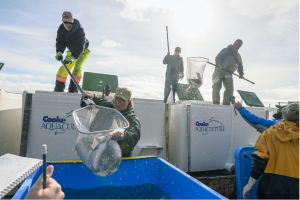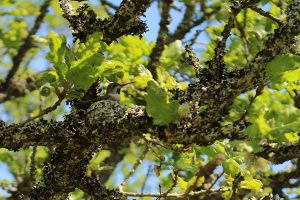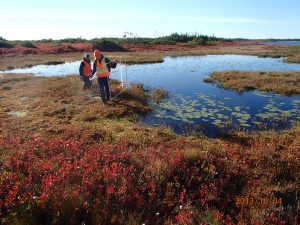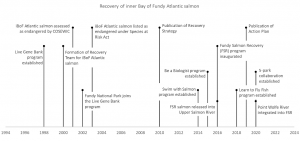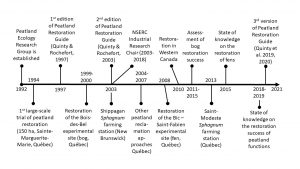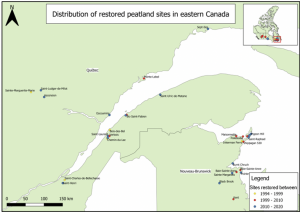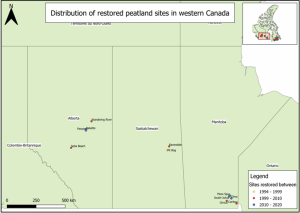Our case studies have gone in-depth into the literature and practitioner-knowledge for each of three ecosystems.
Executive Summary
Fundy National Park (FNP) provides critical habitat to the endangered inner Bay of Fundy Atlantic salmon (Salmo salar). To illustrate how the federal government agency Parks Canada carries out ecological restoration work, we examined ongoing recovery efforts to bring wild Atlantic salmon back to FNP (New Brunswick). Our case study combined document analysis and semi-structured interviews with park restoration practitioners to address three objectives: 1) describe the components of an ecological restoration project implemented by Parks Canada; 2) discuss the effectiveness of applicable ecological restoration policies based on the perceptions of practitioners; 3) identify challenges and opportunities for improvement in ecological restoration practice and policy.
FNP’s work for the recovery of Atlantic salmon extends over 20 years. Implementation of recovery measures within the park started when FNP joined the Live Gene Bank, a program that rears and breeds Atlantic salmon in captivity to conserve the genetic diversity of populations in the region. FNP and its collaborators later established the Fundy Salmon Recovery program, the first wild salmon marine conservation farm in the world. Fundy Salmon Recovery uses a customized aquacultural setting to grow wild salmon in net pens until maturity when adult salmon are released back into rivers to spawn naturally and produce offspring with no captive exposure. These measures have been complemented with monitoring that follows the performance of salmon over life stages and across generations, and three visitor experience programs that combine interpretation, volunteering, and training opportunities to engage the public.
The recovery of inner Bay of Fundy Atlantic salmon has relied on a remarkable number of collaborators: federal agencies, First Nations, provincial government from New Brunswick and Nova Scotia, municipal government, academics, industry, interested civic groups, and volunteers. For all practitioners, this broad collaboration is the most important factor for the success of the project so far. Practitioners also described a successful application of adaptive management, best represented in the use of monitoring data and experimentation to develop the marine conservation farm. Our case study highlights collaboration and adaptive management as two key features of the project while offering a first close look at the national park’s project trajectory.
Executive Summary
Some of the last remaining patches of Garry Oak ecosystems in Canada are found on southeastern Vancouver Island and nearby areas in British Columbia. These ecosystems, having evolved under the stewardship and care of Indigenous peoples for thousands of years, are imperilled from habitat loss and degradation fuelled by land-use-change, increased herbivory, reduction/removal of natural fire regimes, and invasive species. In Canada over 100 rare and at-risk species are supported by these ecosystems, whose value to the community has spurred dedicated volunteers, restoration practitioners, and academics to contribute to their protection and restoration for over 30 years.
We asked how restoration was being done in Canadian Garry Oak ecosystems, and what potential opportunities existed to support restoration in this community. We used two approaches to address our question: developing a database of known restoration projects and searching available grey and academic literature to identify restoration methods and projects. We also conducted semi-structured interviews with restoration practitioners to access unpublished reporting on methodology.
We identified 102 restoration projects within Canadian Garry Oak ecosystems, supported by restoration practitioners, municipal to federal government agencies, non-governmental organizations, and community volunteers. We found two main organizations that collect and disseminate restoration knowledge within the community by publishing best practices, hosting conferences, and managing a listserv. While good information exists on best practices and ecological research supports these practices, formal restoration plans and post-restoration reporting were difficult to access or had not been created for many projects.
We highlight five restoration projects including a rare species introduction, a large urban park that is a hotspot for species at risk, and three park restoration projects that have be spearheaded and accomplished largely through the dedication of many volunteers, over many years.
Executive Summary
In Canada, peatlands cover approximately 113.6 million hectares. This represents 13% of the territory, and accounts for 90% of wetland ecosystems found across the country. Peatlands provide many ecosystem services benefiting humans such as carbon sequestration, and are one of the most cost-effective solutions to mitigate global warming effects. In North America, peatlands are exploited to extract peat from which the horticultural industry is the main consumer. However, this industrial activity requires peatlands drainage and vegetation removal which has adverse consequences on hydrology, biodiversity, and associated ecological service losses. Without human intervention, the degraded peatland may witness several decades of bare soils before typical vegetation spontaneously recovers. In light of this situation, the Peatland Ecology Research Group (PERG) was created in 1992, mainly as a response to a workshop, organized by the Canadian Sphagnum Peat Moss Association (CSPMA), but involving all stakeholders across Canada interested in the management of after-used peatlands. PERG regroups peatland scientists from different Canadian universities and collaborates with provincial and federal agencies as well as the Canadian peat industry. They cooperate on projects aiming towards sustainable and integrated peatland management. For the past 30 years, PERG’s research team has developed peatland restoration techniques and significantly contributed to improving knowledge about the ecological recovery of these specific wetlands. This case study relates how the sustained cooperative and collaborative history of PERG and the Canadian peat industry over the past 30 years has been instrumental in developing a cost-efficient approach to restore degraded peatlands. The long-term partnership and ecological success are a result of the good corporate environmental vision of the industry since the beginning of the 1990s and the unique Canadian Research Council programs to funding industry-university research projects.
